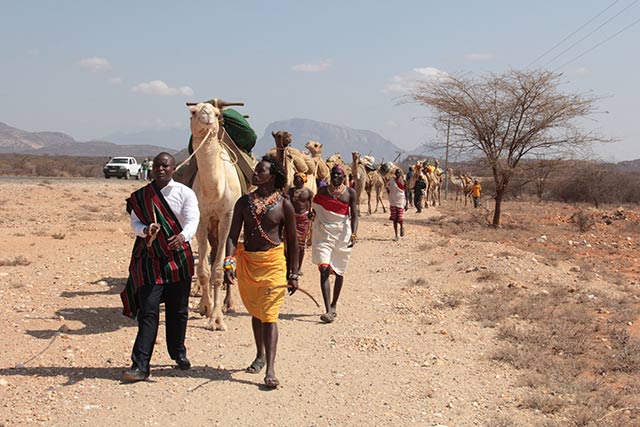
“Had the local district officer not had a swimming pool filled with clean water, maybe there would have been more for us to drink.”
– Bildad Kaggia, Kenyan trade union leader and Central Committee member of the Mau Mau. Prisoner, 1952-61, Lokitaung, British isolation camp for political prisoners convicted of using, “their power and influence over the less educated Africans [to implement] this foul scheme of driving Europeans from Kenya.” (1)
“The future of Kenya is entirely in the hands of the indigenous people.”
– Kaunga, indigenous rights activist, organizer of the Camel Caravan
White highway markings gleam from the hot black tarmac, as if newly painted. The almost completely deserted A2 road, immaculate in its pristine underuse, snakes its way from Nairobi on the way to Ethiopia. Five hours north of Nairobi, the road, a powerful symbol of the modernizing imperative of the Kenyan state, passes through the small, but now rapidly growing, town of Archer’s Post.
In a chilling throwback to Britain’s hideous colonial occupation of Kenya and brutal counterinsurgency war, Archer’s Post still hosts a British military training base, notorious for leaving unexploded munitions that kill and maim local nomadic herders and their children, as well as for frequent sexual assault, rape and violence against local women. Archer’s Post was in part chosen for British Army training because of the dry scrub, intense heat and, according to Lt. Col. Andy Hadfield, commanding officer from the 1st Battalion Mercian Regiment, because of the challenging terrain. Hadfield noted that the Samburu National Reserve, which surrounds Archer’s Post, is similar to the terrain and heat of another postcolonial outpost – Afghanistan: “There are a lot of thorn bushes out there – hostile animals and insects. And, for the soldiers coming here, operating within that environment really makes them better, more robust, and develops their natural fortitude.”
Despite the river flowing through the center of town, the dry and dusty terrain surrounding Archer’s Post, so useful for British Army maneuvers, is symptomatic of a problem the Kenyan government has long known about: water shortage and the lack of infrastructural development. Decades ago, in a more hopeful and politically self-conscious era, it published a prescient and forward-thinking paper on issues facing the newly independent country, which included the need to address water scarcity and degradation. Sessional Paper No. 10 “African Socialism and its Application to Planning in Kenya” (1965) states:
The heritage of future generations depends on the adoption and implementation of policies designed to conserve natural resources and create the physical environment in which progress can be enjoyed. The thoughtless destruction of forests, vegetation, wildlife, and productive land threatens our future and must be brought under control … The conservation of water supplies and productive land through the maintenance of forests and windbreaks, proper methods of land cultivation, and prevention of fire and flood must be actively promoted by Government and the people must be fully informed and their co-operation ensured.
Notwithstanding the aims of that document, more recently, Kenyan professor and hydrologist Francis Gichuki documented in a case study of the Ewaso Ngiro, that the river flow at Archer’s Post has already been cut in half since the early 1960s, a decrease that was “attributed mainly to increasing water abstraction upstream and drought cycles, as there is no corresponding decline in rainfall amounts over the same period.”
 March participants in the march for climate change adaptation and saving the Ewaso Ngiro river. (Photo: Maria Davis)
March participants in the march for climate change adaptation and saving the Ewaso Ngiro river. (Photo: Maria Davis)
Once one factors climate change into the calculations and planning – a key demand of protesters assembled at Archer’s Post in August 2014 – the situation markedly worsens. In a country that obtains 45 percent of its electricity from hydroelectric dams, electricity supply dropped by 40 percent during the drought of 1999 and 2000. As a result of a more recent drought in 2009, electricity supply in the capital, Nairobi, was cut to two days per week in some sectors. As noted in the Kenyan government’s “National Climate Change Action Plan, 2013-2017” report, which seeks to inform the longer-term Vision 2030 plan to turn Kenya into a middle-income country in 15 years, the government acknowledges the likely impact of climate change on a country dominated by agriculture, water shortages and an economy highly dependent on a predictable and stable climate.
Despite the fine words written in 1965, but as noted in the government’s report on climate change vulnerability, development has taken another direction, one that will exacerbate the impacts of climate change:
There is scientific evidence that the frequency of droughts, floods, and other extreme climate events has increased in recent years … The adverse impacts are compounded by local environmental degradation, primarily caused by habitat loss and conversions, pollution, deforestation and overgrazing. Forest cover, for example, has reduced from 12 percent in the 1960s to 6 percent today … Climate change potentially poses one of the greatest challenges for Kenya … The World Bank affirms that “poverty and vulnerability to climate change remain the most critical development challenges facing Kenya.”
Flowing through Archer’s Post, the Ewaso Ngiro River, the only major river in northern Kenya that can generally be depended upon to flow year round, is threatened by a new round of “development,” as the Kenyan government implements its Vision 2030. Changes to weather patterns and rainfall from climate change, which have already appeared to increase the frequency and severity of droughts and other extreme weather events, such as flooding, further threaten an already finely balanced natural and social ecosystem.
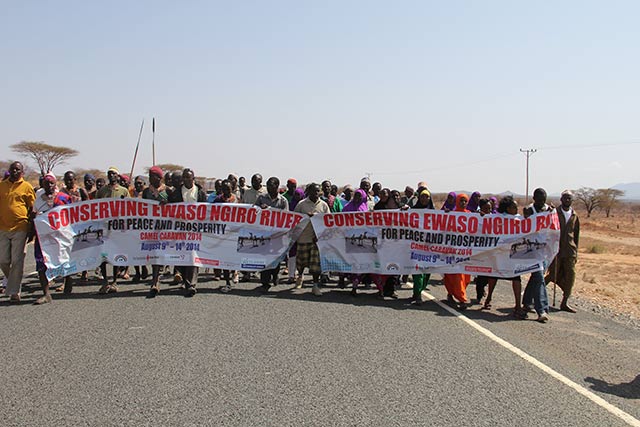 Marchers on the road to Archer’s Post, part of the Camel Caravan of 2014. (Photo: Maria Davis)
Marchers on the road to Archer’s Post, part of the Camel Caravan of 2014. (Photo: Maria Davis)
Kenya’s Vision 2030 plan, on the one hand, does place an emphasis on how to develop stronger and more dependable water resources for a country that is classified as 80 percent arid or semiarid lands. Yet, the government-proposed mega-dam upstream of Archer’s Post, a flagship project of Vision 2030, on the Ewaso Ngiro at Oldonyiso in Isiolo County, looks set to exacerbate, rather than aid, the problem.
The Ewaso Ngiro River supplies water to more than 3 million people, mostly nomadic and seminomadic pastoralists, as well as farmers and urban dwellers, as the river wends its way from the verdant slopes and snow-capped summit of Mount Kenya, the glaciers of which are fast disappearing, through northeastern Kenya, to Somalia and its outlet in the Indian Ocean.
Industrial pollution and untreated sewage from expanding towns and cities are increasing the toxicity of the river.
The Upper Ewaso Ngiro basin covers an area of over 15,000 square kilometers and its varied ecosystems support not only people and their animals, but a rich array of wildlife. The balance of life in the ecosystem is threatened by agricultural development in the highlands around Mount Kenya, particularly more intensive, irrigated farming for export crops, such as flowers. Additionally, industrial pollution, agricultural runoff, untreated sewage from the expanding towns and cities, and periodic low flows are increasing the toxicity of the river upon which so many people and animals downstream depend.
The proposed mega-dam will undoubtedly worsen these grave threats. At a cost of 10 billion Kenyan shillings (US $103 million), the dam will submerge 13,000 hectares (more than 32,000 acres) of land under the resulting lake, as well as five nature conservancies. Assuming there is no drought, it will take more than 10 months to fill the lake once the dam has been completed, which will mean not only lots of people losing the land where they currently live (in addition to land that’s already been commandeered by the Kenyan and British military and into private land trusts as nature conservancies), but also people being subjected to even more severe water shortages from the river as the lake is filled. Not only have local people not been consulted, but the electricity produced by the dam isn’t even for them; it is for a proposed “Las Vegas of northern Kenya” resort city for tourists, to be built in the town of Isiolo.
Despite the fact that only 15 percent of Kenyans have access to electricity, and as the long rows of charcoal piled up for sale along roadways throughout the country testify, over 70 percent of overall energy consumption, particularly for Kenyans in rural areas, comes from biomass – charcoal, wood and animal manure. In fact, as inequality and poverty have worsened, the percentage of Kenyans dependent on biomass for their energy needs has risen from 73 percent in 1980 to 83 percent in 2014.
Harkening back to that earlier period of colonial resistance and unity, in August 2014, Archer’s Post was the scene for something much more hopeful, as the A2 was crowded with hundreds of singing, marching and protesting members of three different tribes, complete with some of their camels. For the more than 200 pastoralists who began the march at Merti Township, Archer’s Post marked the end point of their 250-kilometer trek to protest the proposed mega-dam upstream on the Ewaso Ngiro River, at Oldinyiro.
Even before climate change, Kenya was classified by the UN as a chronically water-scarce country.
The second annual Camel Caravan for Climate Change Adaptation was a joint production of members of the Samburu, Borana and Turkana tribes, who are among those, along with the Rendile, Somali and Maasai communities, who will be directly affected by upstream changes to water flow caused by the proposed dam. Various nongovernmental organizations, such as Cordaid and Wetlands International, are supporting pastoralist communities in their attempt to have some say in the dam proposals. All the people with whom I spoke at the demonstration, however, made it abundantly clear that if they had their say, the dam wouldn’t be built at all.
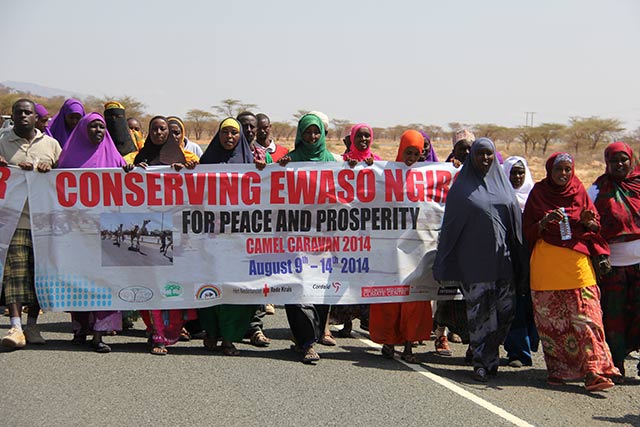 Female members of the Borana tribe leading the march. (Photo: Maria Davis)
Female members of the Borana tribe leading the march. (Photo: Maria Davis)
Even before climate change, Kenya was classified by the United Nations as a chronically water-scarce country. According to the UN measure of water availability suitable for humans, availability in a particular location must exceed 1,000 cubic meters per person per year. (Countries that don’t meet that minimum are classified as water scarce.) Kenyans average only a little more than two-thirds of that figure, 647 cubic meters per person per year, equivalent to Syria and Egypt.
However, even that low average amount of water hides massive disparities in water availability between urban and rural dwellers, individuals and irrigation for farming, as well as industrial and tourist purposes. It also obscures the fact that most of Kenya’s water resources are not actually available for use. A 2006 World Bank report noted that only 15 percent of Kenya’s renewable water resources have been developed, helping to explain the huge shortfall in water availability, despite Kenya possessing “sufficient water resources to meet demand” and allow all Kenyans sufficient access to adequate supplies of water in line with UN guidelines.
The government is currently providing fewer and fewer funds for water management, and the World Bank predicts a steadily worsening situation:
The combination of a limited endowment of water and high temporal variability in its delivery – coupled with an economy that is very dependent on water, an absolute decline in investment in capital infrastructure and maintenance of existing infrastructure, and the increasing degradation of catchments, lakes, and aquifers – means that Kenya now has very low water security. In other words, the country is highly vulnerable to climate variability, both droughts and floods.
Nonetheless, there is a huge question mark, highlighted by the pastoralists protesting one of the flagship developments of the 2030 plan, regarding whether the construction of the mega-dam at Oldinyiro will increase climate resiliency or damage it. In their view, the answer is clear: The dam must not be built as it directly threatens their livelihoods.
 Samburu Women join the march. (Photo: Maria Davis)
Samburu Women join the march. (Photo: Maria Davis)
The deputy governor of Isiolo County, Mohamed Guleid, who spoke at the Camel Caravan, told Truthout earlier this year via email that even he – let alone the pastoralists – has not been told any details about the mega-dam, or its impact on downstream water users:
The camel caravan raised issues pertaining to the negative consequences of the dam on the population in areas around Merit and other settlements. I think they have a legitimate concern, which I equally share. However I have yet to see any report on the environmental impact assessment. Equally I have not seen the engineering design and whether the dam will severely affect the flow of the river and the volumes of water during dry seasons.
Pastoralism in arid and semiarid lands is the most ecologically sustainable method for surviving in a water-stressed environment. This is why so many people in East Africa are pastoralists, and have been successful at it for so long. Despite official rhetoric to the contrary, pastoralism plays little role in Kenyan government thinking about the future of Kenya – other than as something to eradicate because certain powerful forces consider it “backward.” No government wants 18 percent of its people wandering around independently sustaining themselves, their very mode of life offering a subliminal challenge to capitalist standards of land-use and private property norms, in relative autonomy from central state control, often with grazing ranges across the borders of other states.
The Kenyan government states that pastoralism accounts for a full 10 percent of Kenyan GDP – a figure that is no doubt a huge underestimate, as it only accounts for direct monetary benefits. It also accounts for 95 percent of pastoralist family income. According to Ced Hesse, a senior researcher on drylands at the UK-based International Institute for Environment and Development, “Pastoralism, if it is allowed to function properly and in response to the dynamics of the arid and semiarid lands … is the most sustainable economic system for these areas that will support millions of pastoralists directly, many more millions of people indirectly through the value chain of its products [like] milk, meat, manure for farmers, coexistence with wildlife and thus the whole tourism trade.”
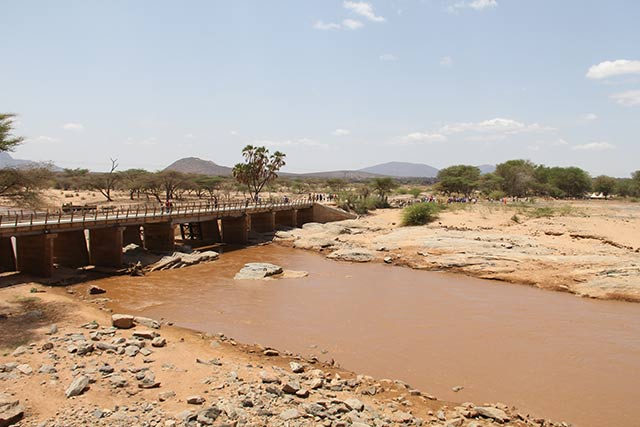 Marchers crossing the river they are trying to protect; the Ewaso Ngiro. (Photo: Maria Davis)
Marchers crossing the river they are trying to protect; the Ewaso Ngiro. (Photo: Maria Davis)
As I documented in Vietnam, a top-down, government-driven push to expand the economy at breakneck speed requires a plan for energy and water use that focuses on giant mega-projects, such as dams, at the direct expense of the people and animals already using the water, whether we are looking at the Mekong River or the Ewaso Ngiro. Just like Vietnam, Kenya is praised by the World Bank for its development policies and business-friendly investment climate. It is a climate Kenyan President Uhuru Kenyatta boasted of at the World Bank headquarters during a meeting to discuss financing for energy and infrastructure in August 2014 in Washington, DC: “We want to take advantage of the vast economy of the US and we have made progress in improving our legal systems to make our region more business-friendly … we will do everything to facilitate your entry into our market.” (2)
“The river is dying and something must be done. If the river dies, everything will die.”
The camel caravan was consciously organized to bring together members of different communities and tribes in order to show a united front against the dam, and show that a history of sporadic violence between different groups can be overcome through political organizing around a common demand. To emphasize this, one of the main songs sung on the march was a melded mixture of Burana and Samburu languages. Women walked at the front of the march to emphasize that they will be the first to be affected by the drying of the river.
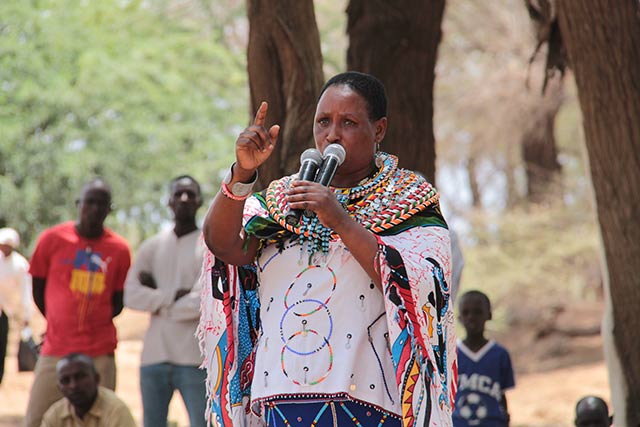 Rebecca Lolosoli, activist and social worker in Samburu for 24 years. (Photo: Maria Davis)
Rebecca Lolosoli, activist and social worker in Samburu for 24 years. (Photo: Maria Davis)
One of the march organizers, a member of the District Peace Committee in Isiolo County, Dabaso Halkano, spoke while marching: “We have power, even though we are poor – people power, and that makes us strong. That is why we are demonstrating. They talk of resilience. I want to talk of resilience and climate change, not bore holes and dams. We have our own resilience. We are going to cry to save the river. We are crying to the world to hear us.”
The march’s mission rose beyond stopping the dam; it touched on many other pressing issues in Kenya. Dressed in a flowing green dress and headscarf, Darmi Goio, a schoolgirl from Muthambi Girls High School, who completed the walk, spoke at the rally that concluded the 250-kilometer march. She told the assembled crowd that she and her other school friends “are fighting for the equal representation of girls and women against this patriarchal society. There are two groups in the world. I am speaking on behalf of the people who don’t have power to the people who do.”
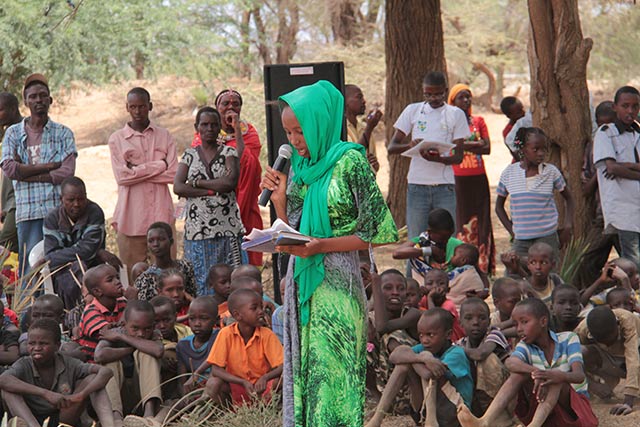 School girl and marcher Darmi Goio addresses the rally against the proposed dam. (Photo: Maria Davis)
School girl and marcher Darmi Goio addresses the rally against the proposed dam. (Photo: Maria Davis)
People who completed the 250-kilometer walk received medals to recognize their contribution. Young Samburu warrior Raine Lempira proudly displayed his medal, saying that, “I feel very good about the medal because I have walked to raise awareness of the river and that will help me for many years, and future generations.” He emphasized the purpose behind the struggle: “The river is dying and something must be done. If the river dies, everything will die.”
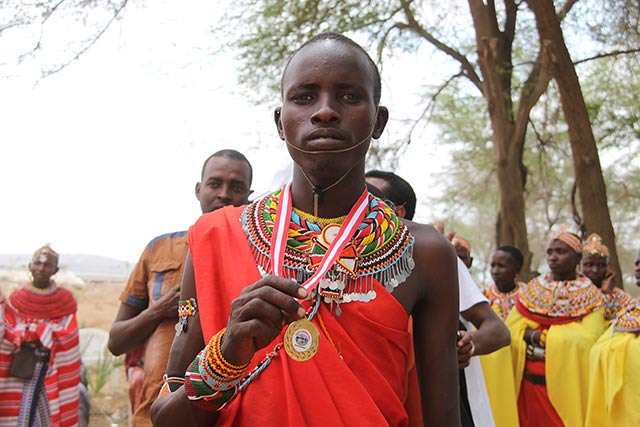 23-year-old Samburu warrior Raine Lempaira. (Photo: Maria Davis)
23-year-old Samburu warrior Raine Lempaira. (Photo: Maria Davis)
There are many more constructive, inclusive, appropriate and ecologically sustainable ways Kenya could supply more electricity and water – and guarantee water security and electricity to those who don’t have it. But they are very different from the dam, and from the giant wind farm proposed for Lake Turkana (which I wrote about in a previous article). Like the wind power project, the dam will be built by international corporations, aided by loans from Western financial institutions. They will take little account of the needs or desires of local people, for whom the electricity and water are never intended.
As Jacques Leslie wrote in his book-length study of global struggles against dams, Deep Water: The Epic Struggle Over Dams, Displaced People, and the Environment:
The larger the dam, the more expensive its dismantling becomes, until, in the case of a hydroelectric mega-dam, the expense may surpass the cost of erecting it. Imagine these dams in five hundred or a thousand years … when every one of them suffers from an altered hydrological regime as a result of climate change … like Stalinism and gasoline-powered cars, symbols of the allure of technology and its transience, of the top-down, growth-at-all-costs era of development and international banks, of the delusion that humans are exempt from nature’s dominion, of greed and indifference to suffering.
To improve water storage, rather than building dams, a much cheaper, more effective and longer-lasting answer would be to build smaller-scale water storage facilities. It is an ancient practice that the Samburu have perfected, as they dig wells for their cattle that become watering holes for elephants and other animals at night. Elephants play a key role in the local ecosystem: They let other grazers know an area is safe; with their passage, elephants cut up brush and thorns for other animals to graze, which create firebreaks; they fertilize the ground and spread seeds. Indeed, some seeds don’t reproduce unless they first pass through an elephant’s digestive system.
While there are plans to bring solar power to Kenya, once again, if those prove real, they will probably involve a giant techno-project focused on industrial-scale quantities of power for urban, agribusiness and tourist areas, rather than rural electrification projects, where the majority of Kenyans still live.
What needs to change is not so much the sources of electrical power, but the sources of social power.
Cell phones for nomadic herding communities are one of the single biggest technological innovations that are resoundingly beneficial. As a way to communicate about which are the best markets to go to that day in order to get the best prices on livestock, to spreading information about water holes or warn of raids, bad weather or accidents, cells phones have radically improved the safety and economic security of pastoralists. With so little access to electricity, however, charging them at what is often the one place in town with access to electricity is expensive. Similarly, the lethal health effects and ecological damage of cooking with wildly inefficient open stoves, using biomass as fuel, and kerosene lamps for lighting, could be displaced by decentralized rural electrification in a country blessed with abundant solar energy.
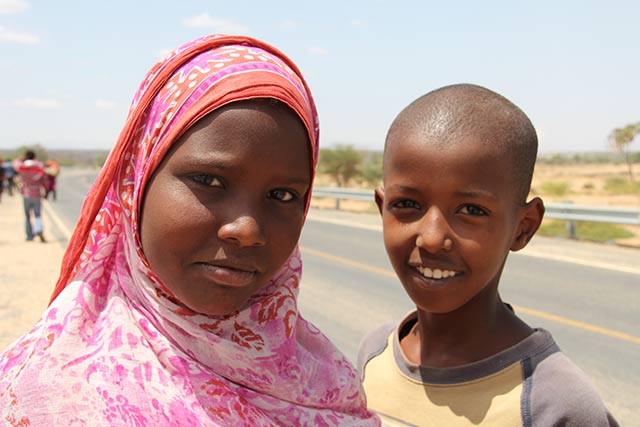 Young Marchers head toward the rally against the dam. (Photo: Maria Davis)
Young Marchers head toward the rally against the dam. (Photo: Maria Davis)
Another small-scale resource – simply providing more efficient kilns – would have a significant impact on people’s lives, as they wouldn’t have to spend days collecting wood and burying it underground to partially burn in a limited oxygen environment in order to make charcoal. The capital required for these projects would be much smaller, and would involve local labor and decision-making.
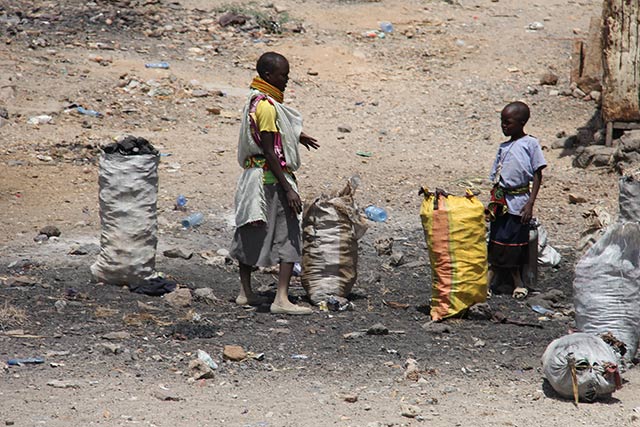 Turkana selling the ubiquitous charcoal along the roadside of the A2. (Photo: Maria Davis)
Turkana selling the ubiquitous charcoal along the roadside of the A2. (Photo: Maria Davis)
The process of developing Kenya’s untapped water resources and storage capabilities could be done much cheaper, much faster and with considerably more equity and long-term sustainability than any of the multimillion-dollar plans currently under consideration. But who decides which route Kenya takes? An effective solution that takes the people’s needs into account would require the necessity of social control and genuine democracy through the rearrangement of social relations. What needs to change is not so much the sources of electrical power, but the sources of social power.
To that end, in an interview with one of the main organizers of the camel caravan, Kaunga, a former UN employee and now tireless activist and organizer for indigenous rights in Kenya, Truthout asked where the camel caravan fit into the overall strategy to rearrange social power. Kaunga, who has been involved in activism to save the Ewaso Ngiro River from upstream development since 1998, said that considerable awareness had been raised for downstream communities as a result of the second march, and it had helped to bring different tribes together in the struggle. He added that, considering the giant economic forces at work, only escalation – the bringing of more people into the protests – would bring the possibility of success:
We need to broaden the debate. We need to target where the flowers are going. Kenya as a country, as a state, does not respect environmental laws. They have never opposed a project. The next step is to organize the women, then next year, youth and school children. We need to organize a march of cultural resistance, and next time march on Nairobi. A school boycott in northern Kenya – they have worked in other countries – they could work here.
I asked Kaunga what he would do if they started building the dam. He took a moment, then responded: “I will be one of the people to organize the nomads to get guns to oppose it.”
Footnotes
1. Quoted in Caroline Elkins, Imperial Reckoning: The Untold Story of Britain’s Gulag in Kenya. (Owl Books, New York. 2005) 195-6
2.Saturday Nation, Kenya. August 9, 2014.
Join us in defending the truth before it’s too late
The future of independent journalism is uncertain, and the consequences of losing it are too grave to ignore. To ensure Truthout remains safe, strong, and free, we need to raise $50,000 in the next 9 days. Every dollar raised goes directly toward the costs of producing news you can trust.
Please give what you can — because by supporting us with a tax-deductible donation, you’re not just preserving a source of news, you’re helping to safeguard what’s left of our democracy.